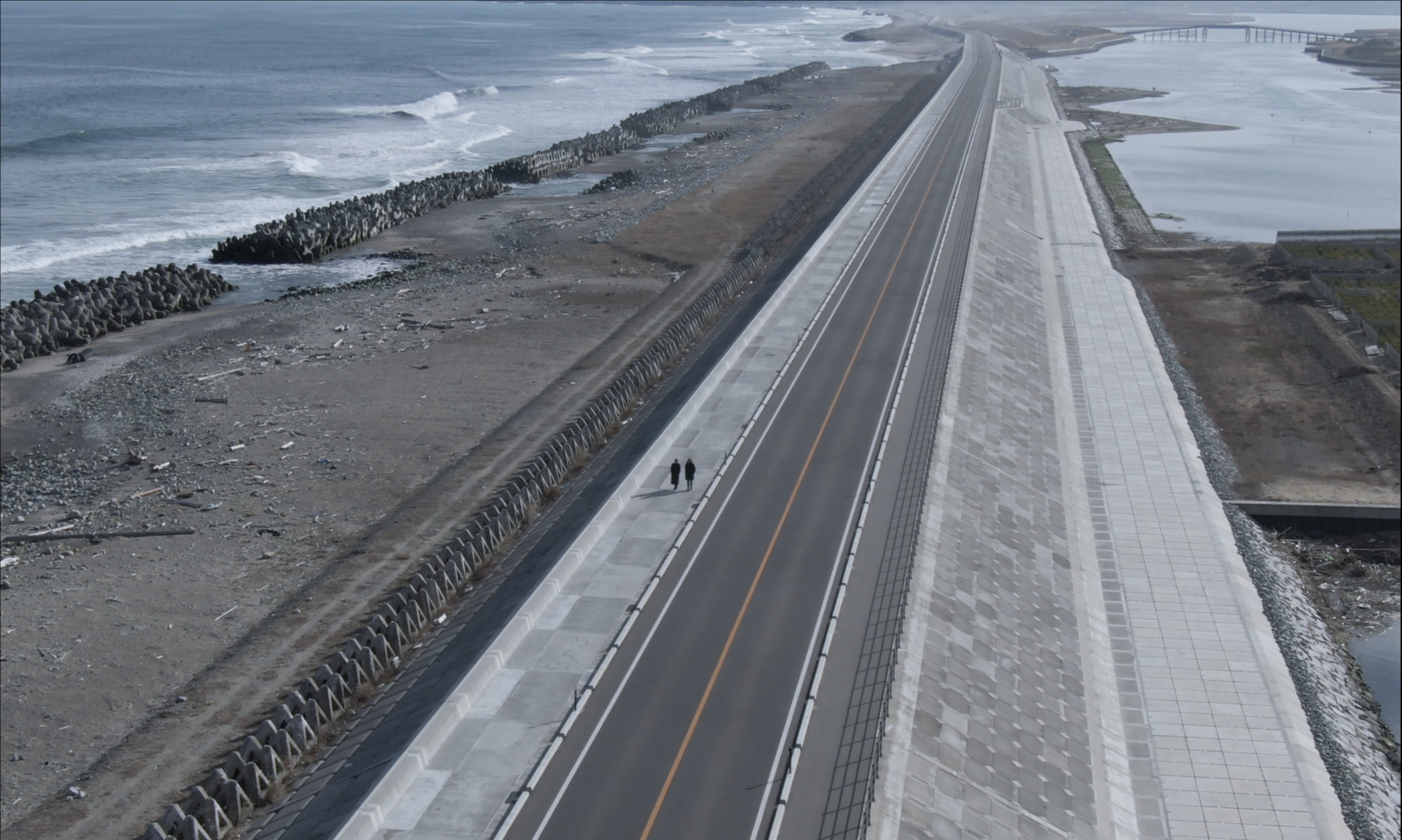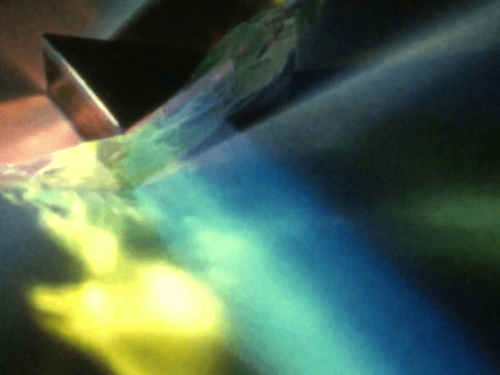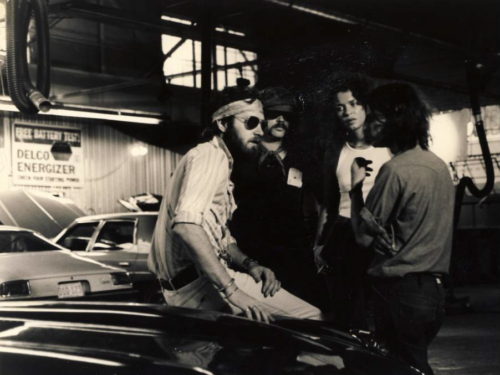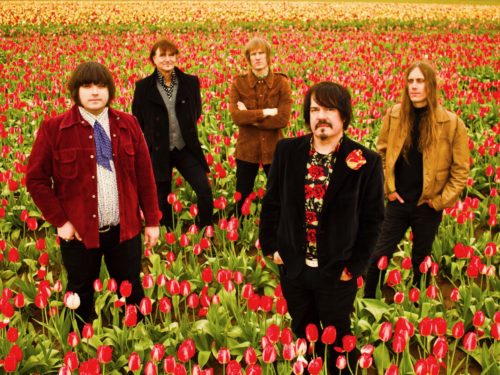To preview the 2021 Flickers’ Rhode Island International Film Festival, Robert Delany discussed some of the most exciting films with their creators. Up today is Emmanuel Fraisse on ÆON
Emmanuel Fraisse’s ÆON (Japan, 2021) is a narrative short film set during an emergency evacuation of Japan. Grounded in the director’s experience seeing the impact of the 2011 Tōhoku earthquake and tsunami and the Daiichi nuclear disaster in Fukushima — the damage of which is still visible on Japan’s landscape today — the film follows a young woman reflecting on memories of a mysterious girl from her past and musing on the mythical lost city of Atlantis. In a style influenced in part by Chris Marker’s still-image science fiction classic, La Jetée (1962), Fraisse builds a relationship between the city and the ocean, while using the ancient Greek mythology to explore our current times.
In an email interview, Fraisse wrote about the benefits of shooting with a small crew, the bridge between nature and civilization, and the film’s “almost static” shots that provide its unique visual style.
ÆON seems to be heavily influenced by Chris Marker’s La Jetee. The static shots, contemplative pace, and certain places like the airport or objects like statues are framed in a way that reminds me so much of Marker’s film. What made you want to pay homage to such a landmark experimental film?
Emmanuel Fraisse: I wouldn’t say that it is an homage, but La Jetée is inspiring in Marker’s minimalist approach to production. Filmmaking is too often about time fighting money and organization. Chris Marker made a moving and lyrical science-fiction fable, and yet it was made by the smallest crew and cost almost nothing. Our work process, having no gear but a photo camera, allowed me to work for a long time (compared with most short films), far from home with people I care about, in a peaceful and quiet mood. For the same reason the sound was all made in post-production by editing, designing and foley recording. I work as a cinematographer so I know how difficult it can be to find the time you need to wait for the perfect light, to try things, miss, try again.
We shot video in real time (not in slow motion) with quite classic technical breakdown. With Raphael Duracell, the editor, we strongly reduced the speed footage to work on pictures that are ”almost” stills but keeping subtlety in the movement of the shot. We used digital interpolation, a software device that recreates new frames to render a realistic rate. The film is all about the narrator trying to plunge into her memories, so we considered this as a relevant way to embody her subjectivity.
In ÆON there is a through line of Greek Mythology with the story of Atlantis. What drew you to this story for the film?
The point with mythology is that, even if it comes from far away, it may often tell something about our times. With Atlantis, maybe Plato was referring to a real ancient civilization, or maybe it was just a warning for Athens when he wrote Timaeus and Critias, but it didn’t really matter to me. I suppose the loss of the text ending just adds a layer of mystery, and this probably contributes to the story’s presence in pop culture nowadays. No one knows if Atlantis has existed for real, and if so, where is the rest of it? So the fiction starts there. Some have searched for it in the Atlantic Ocean, of course, but also on land in Spain near Gibraltar, Heligoland and even in the Arctic. So, why not in Japan? And if it has never existed, why would it even belong to the past? Couldn’t it be a kind of prophecy?
The relationship between the ocean and the city seems to play a central role in the aesthetics of the film. How did you want to contrast the presentations of the sea and urban areas?
When I came to Japan in 2017 for my graduation work Bloom, I had been struck by the infrastructures on actual Fukushima shores. All these anti-flood walls, solar panels, and wind turbines replacing nuclear power plants, with the fields of radioactive waste packed in trash bags, and of course, the three-kilometers-long no man’s land where the tsunami destroyed everything. Japan is an archipelago over four tectonic plates crossing underwater, which makes it one of the most exposed territories to earthquakes and tsunamis. Yet the country lives with the ocean, the dense cities are located on the coasts while there are fewer and fewer people living in the mountains. Some important parts of the cities that you can see in Æon are built on extensions above the water, like the Kansai International Airport or the artificial island of Odaiba. It was important to me not to shoot nature and civilization as opposite entities but to look towards the junction points between them. In other words, to make a bridge.

One of the most visually striking parts of ÆON is during the Aquarium sequence, where the people seem to be as suspended in time as the sea creatures float in their tanks. What drew you to that space in particular?
The aquarium is literally a space where the city encounters the sea. In a forced way, of course, but I imagined no other place for the first meeting of the two characters. Into the water, time suspends itself. Children seem to forget the glass tank, as they would forget the screen in a theatre. Because of its construction and scenography, you can be from one side and gaze at someone through the water, without being seen. The captive animals in between hide you. I guess this is why there is more sadness in this kind of place than in any abyss.
Something connected to both the sea and the aquarium is the blue color grade of the film. How does the color design factor in with the other aspects of ÆON?
I wanted the visual aspect of the film to be dark and cold as it could have taken place in the engulfed city. However, it has not so much to do with the color grading process. It comes more from the choices during the shooting and the editing to avoid red and warm tones, except when it came from the natural sky’s colors. As a spectator it always bothers me a little when we can feel that some filter has been added in post on the whole film. In France, you would say it may be due to professional deformation.
Due to filming during the pandemic there are many empty spaces throughout ÆON. What was it like to see these places so devoid of people, and what made you want to film in that environment?
Unexpectedly, the virus did not change the film at all. It was all imagined and written before the first cases in Wuhan. I had shot Bloom two years before and it was already dealing with catastrophes you never see and people vanishing from cities. Of course, now it may look confusing because of the empty street shots. However there never was any lockdown in Japan. The government was denying cancelling the 2020 Olympics at the time. Besides, a lot of sequences have been shot in Fukushima prefecture, which is quite empty for other reasons we know.

The voiceover performance is a standout part of the film. How did you want the narration to feel for the viewer?
At first, with Simon Serna, who wrote the script with me, and then with Victoire du Bois, who performed the narrator’s voice over, we were looking for the same thing. We knew that even if the meaning was primordial, the rhythm and fluidity of the language were equally important. The text and the way to say it should sound like a spell, between hypnosis and stories you tell children so they can get to sleep. It was all about slowing down the spectator’s attention, which comes and goes so fast with most movies. I was sometimes told in my previous works that it was too slow. But I think if you drift away during the projection or confuse a myth with another, it may be positive. I mean if it makes you sleepy then you lower your guard, and from that moment you might feel emotions you probably would have not felt otherwise.
There is a sequence when you are filming a beach at low tide and we see an intricate maze of canals in the sand as the sun sets. Many other photographers capture the same scene in front of you as well. What drew you to this stunning natural scene?
Once the shooting officially completed, my friends and I decided to go across Kyūshū, the Japanese southwest island. We reached that amazing location by chance the exact day the sunset was synchronizing with this particular low tide moment. The weather was so clear that people from the whole region had come to take photos because of its rareness. So I filmed them. We felt a strong melancholy there and agreed that this scene should be in the final movie, even as an aside of the main plot. Of course, this imagery may blend with the myth of Atlantis and the 2011 events, but I didn’t want to emphasize any hidden meaning about it.
Related: Program Director Shawn Quirk Previews the 2021 Flickers’ Rhode Island International Film Festival
You take a detour in the film away from the main narrative to discuss a character we never see named Takashi, who seems to be a reference to Takashi Miyata, a famous survivor of the bombing of Nagasaki. ÆON’s Takashi seems to reference the 2011 Tōhoku earthquake, tsunami, and Fukushima Daiichi nuclear disaster. What role does this addition play in the overall narrative of the film?
At the time I was collecting information about the consequences of radioactivity on people living in Fukushima today, and one of the young men from a documentary really stuck in my mind. We combined different stories to write a new character, but I kept the name, I can’t really tell you why. I have heard about Takashi Miyata since, but it is just a coincidence. But it can refer to the nuclear history as well, though. For 65 years Japanese people had no other choice but to deal with it. The government wanted to prove the country had recovered its strength by hosting the Olympics in Tokyo, 1964. In 2011 the traumatism came back within a different form. And a few years later the Olympics come back, too. Takashi carries this legacy for his people like it was a curse. It is not about his own person and that is why we didn’t want him to appear on the screen.
Some of the most striking moments in ÆON are the most abstract, like the dream sequence about the temple of Poseidon, or the jellyfish floating across the protagonist’s face in the aquarium. How important are abstract moments like these to you in the composition of the film?
It depends on what you call abstraction because these two sequences do represent characters, so I would say they are figurative. But if you mean that these moments might be unnecessarily long or that they seem to leave the narration, I see your point. Still, I make no fundamental difference between narrative and abstraction in the way the film was made. I was told often that, because I come from both cinematography and music, I might not pay attention to the script so much. I do believe that storytelling is crucial, but I think it is even more important when it makes you change the way you feel things in front of a gaze, a piece of music, a light ray, the slightest smile. That feeling when you have walked a long path and you finally reach the chasm. I couldn’t tell if this vertigo is still due to the sequence itself or to what had preceded it. It is about leaving small white pebbles to condition the mind to be vulnerable for a moment, beyond space and time, beyond pictures and script. At least, this is why I watch movies.
ÆON will be available to stream with Wednesday’s “Life In Fragments” short film showcase
Bande annonce ÆON, de Emmanuel Fraisse from Caïmans Productions on Vimeo.
Stay up to date with all things Split Tooth Media and follow Robert on Twitter
(Split Tooth may earn a commission from purchases made through affiliate links on our site.)





